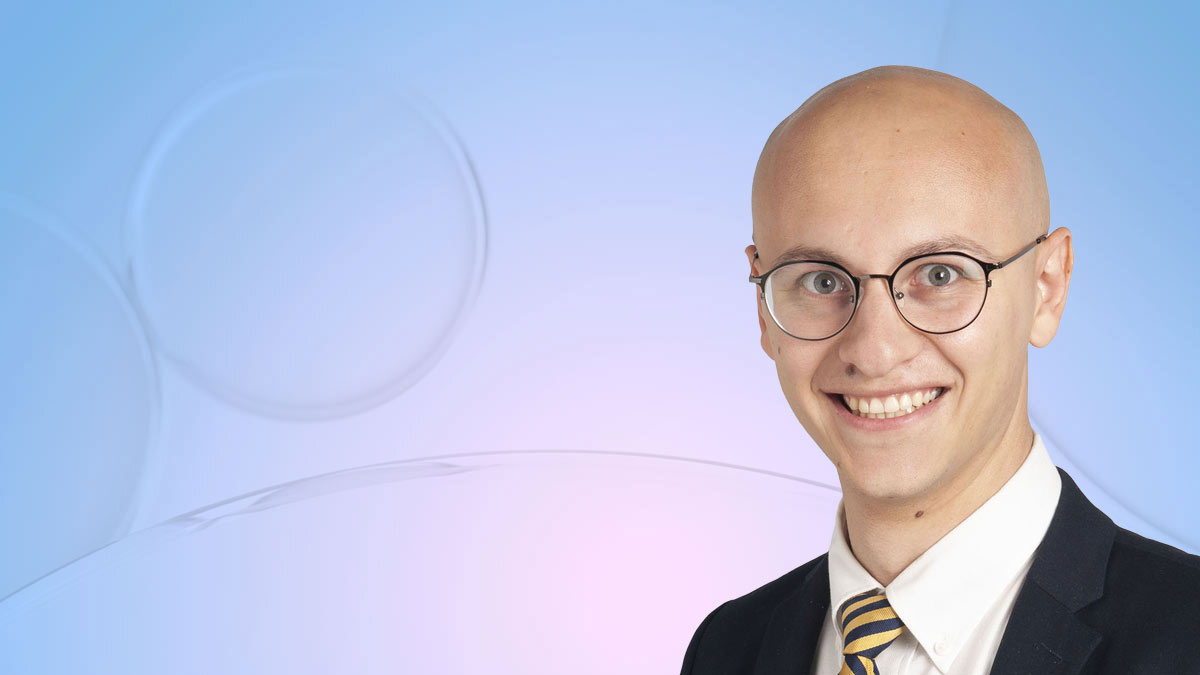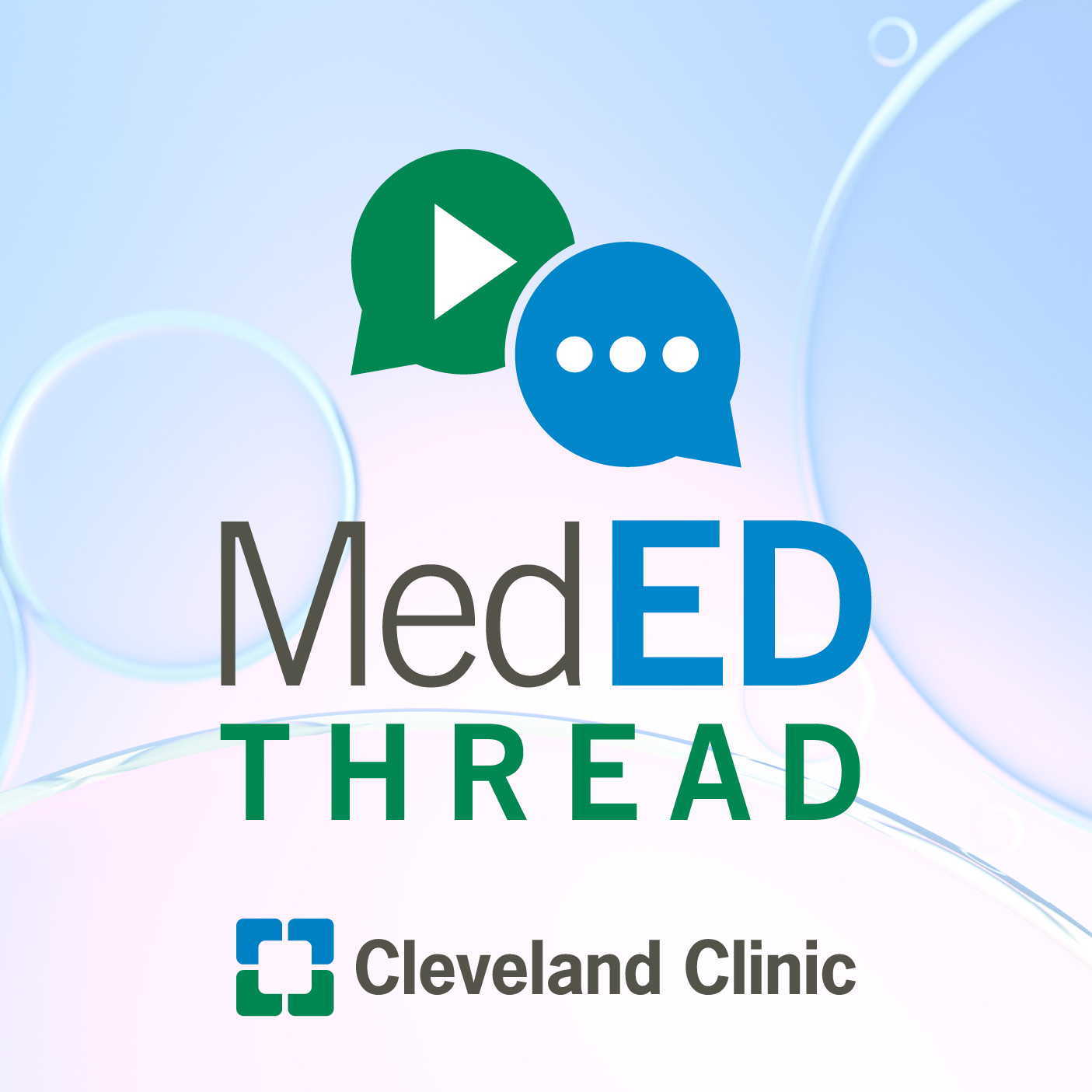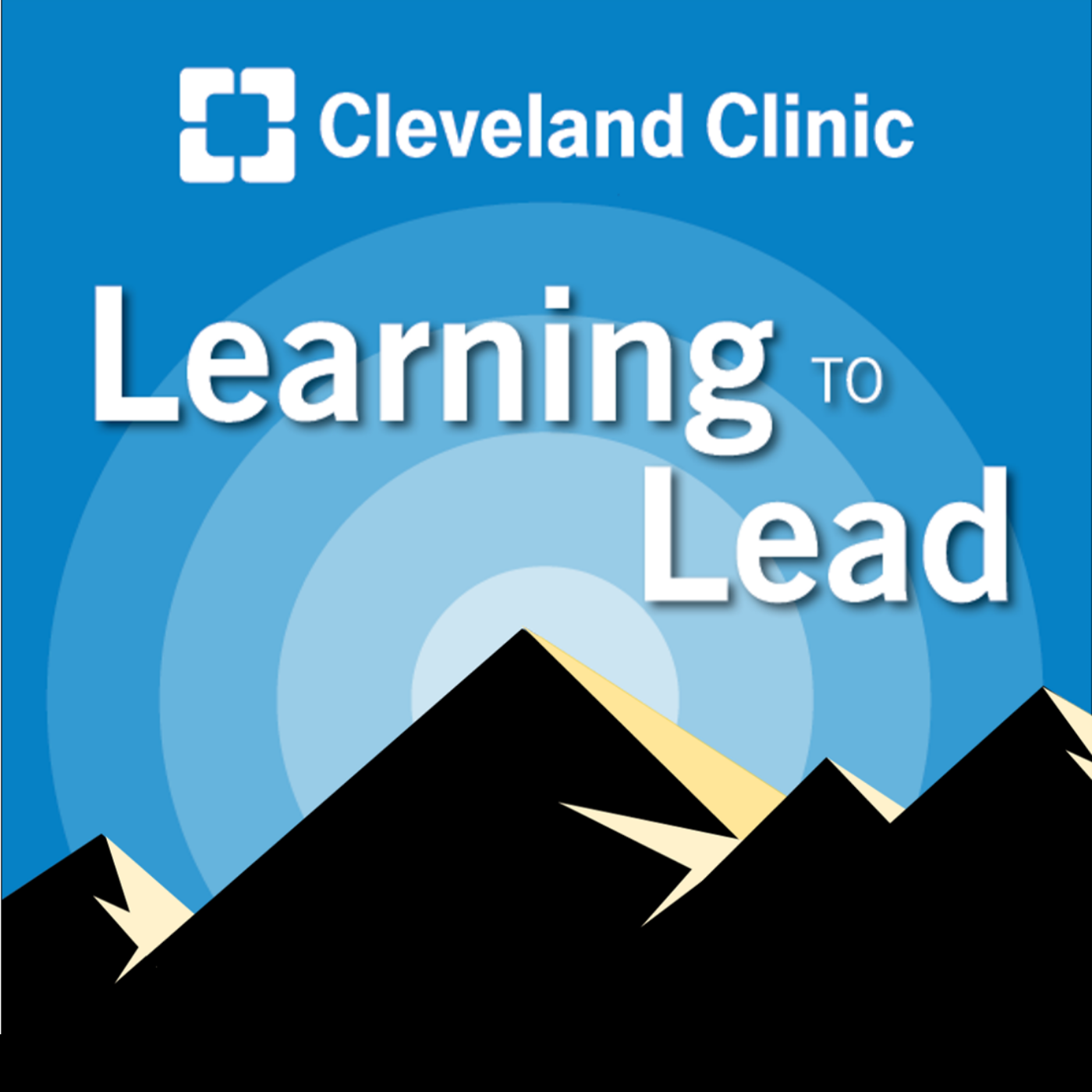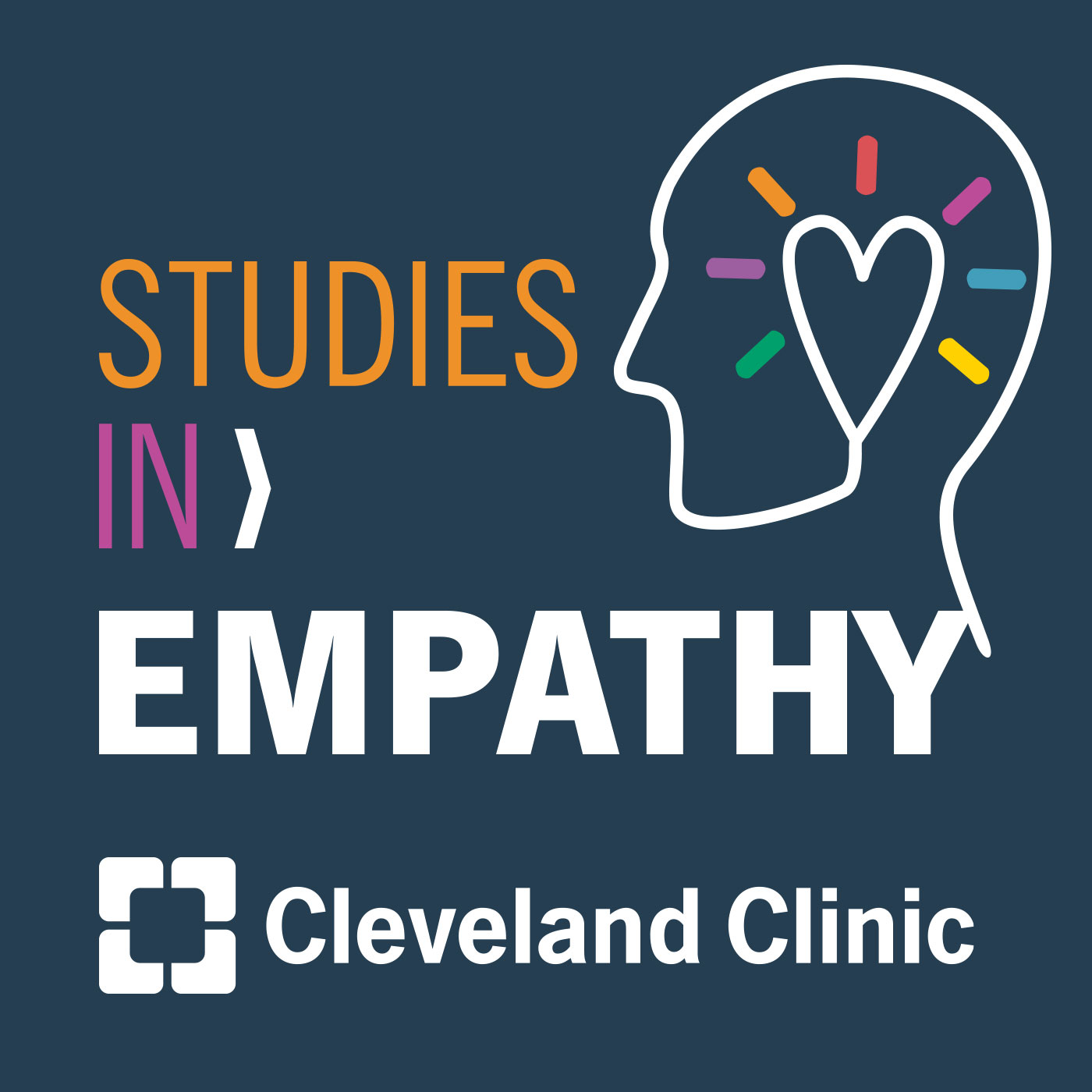A Practical Approach to Addressing Resident Burnout

In this episode, we talk with Jeremy Weleff, DO, who discusses practical approaches for addressing resident burnout and provides insight into what residents can do personally to combat burnout.
Subscribe: Apple Podcasts | Podcast Addict | Spotify | Buzzsprout
A Practical Approach to Addressing Resident Burnout
Podcast Transcript
Dr. Jamie Stoller:
Hello, and welcome to Med Ed Thread, a Cleveland Clinic Education Institute podcast that explores the latest innovations in medical education and amplifies the tremendous work of our educators across the enterprise.
Dominique Pishotti:
Hello everyone, welcome to today's episode of the Med Ed Thread, a Cleveland Clinic Education Institute podcast. I'm your host Dominique Pashadi, Department Manager within the Education Institute in Cleveland, Ohio. For today's session, we will be joined by Dr. Jeremy Weleff, who will discuss the practical approaches for addressing resident burnout.
Jeremy is a research fellow here at Cleveland Clinic, and is concurrently working on an addiction psychiatry fellowship at Yale School of Medicine. During his training at Cleveland Clinic, he served as a House Staff Association Officer for trainee wellbeing, and led several projects dedicated to improving resident and trainee wellness.
He also founded The Wellness Council, the first of its kind within Cleveland Clinic graduate medical education. Jeremy, thank you so much for being here today. We're very excited to hear from you and learn more about your involvement in addressing trainee burnout and wellbeing.
Jeremy Weleff:
Thank you, Dominique, it's always a pleasure.
Dominique Pishotti:
So, Jeremy, as someone who has completed residency training, you know firsthand the effects of burnout associated with the trainee programs. Can you share with us a little about how you got involved in finding ways to better address this burnout, and if it's something you would say stems from your medical specialty in psychiatry?
Jeremy Weleff:
Yeah, absolutely. So, I'd first start off by saying that I think burnout and these issues are just so insidiously present in labor and in clinical medicine today, and I found myself getting interested in this issue as a medical student, and when I came to the Cleveland Clinic and joined the House Staff Association and the Wellness Committee, and I saw just something needed to be done. And I think it's probably similar to why I went into psychiatry was that I hate to see people not functioning at their best, or unhappy, and I think I find that's particularly true when it comes to work. We spend so much time working and I think people should really be upheld and comfortable in their workspace.
And so, I think seeing burnout impact the people around me, friends, colleagues, and, I think it was just clear that I needed to do something and be involved. I find myself consistently trying to make things better and I think we needed to push the needle further when it came to physician wellbeing and burnout. So, that's how I got into it.
Dominique Pishotti:
Awesome. So, you know I feel the term burnout has become increasingly more common, especially since the pandemic. How is burnout directly impacting the trainees, and can you share with us why it's become such a problem?
Jeremy Weleff:
Absolutely. I think they span across labor and medicine, and I think a lot of people just really feel unhappy and confused in their work often. When it comes to GME, when it comes to medical education, we know that about 25 percent of medical students are burnt out before they enter residency training. So, trainees are inheriting folks that are maybe cynical, maybe already emotionally exhausted, and not only are they expected to continue to perform at their best when it comes to clinical care but they're expected to also be a learner, and also be somebody with a family, and somebody who's a part of their community, and it's a lot of pressure.
So, we inherit medical students that might be facing burnout. In some of the surveys when it comes to medical residents, rates of burnout can be, have been upwards of 75 percent. In a lot of the physician samples, it's somewhere around 50 percent. And this is important. Not only on a very personal level, but it's also important for patients, and we know that physicians and medical staff that are burnt out, we know that it impacts patient safety and quality, and we have a moral obligation to do our best, not only to our trainees, staff, organizations, but also to our patients to make sure we're properly addressing this. It's not only physicians and medical residents and students. We know that rates of depression in nurses is about 20-40 percent when they're asked. We know that other medical professionals also, ranging from 35-50 percent, simply don't care for themselves. They don't seek medical or mental healthcare when they personally feel that they may be having symptoms.
So, we have a duty, really, and it's been about 40 years since the Maslach Burnout Inventory, one of the main tools that we use to measure burnout was created. And there's simply more to do, and we have this obligation to do it.
Dominique Pishotti:
Absolutely. So, you point out that there are a lot of moving parts that affect trainees on a day-to-day basis, and you also point out that this does have an impact on patients. So, what are some practical approaches that can be taken to improve the resident wellness and trainee wellness all around?
Jeremy Weleff:
Absolutely. I think about this structurally. I think that there are so many different levels to this and layers to the issue. Thinking structurally about physician wellness means addressing the root causes of these outcomes, and it means that each individual training program or GME or employer should be cataloging, addressing these factors in really a deliberate and lasting way.
Often, nationally, there's a lot of token gestures uh of wellness that are sometimes made, and I think people are ready for a longer, bigger, enduring change. And so, I think of this as a top-down and bottom-up approach to resident wellness, starting at the top. Leadership has to be willing not only to come out loudly and speak out loudly about burnout and the issues we're facing, but it has to be supporting change, and there are a couple guidelines provided by the ACGME about what are some of the minimum requirements that residency training programs have to have when it comes to resident wellness and I think we should be pushing for a higher bar. I think we should be holding ourselves to the highest possible standard when it comes to this issue. A. for patients, B. for our staff and trainees, but C. just simply because it's the right thing to do.
There are lots of published frameworks and strategies on how to do this, and I think we need a deliberate approach to this. That being said, leadership can't be tone-deaf to these issues and I think of this kind of as a bottom-up approach at times where the programs or the implementation should reflect the culture and the needs of that specific institution or that specific group. So, by being a good listener and by being a leader that's in tune with these and by making sure that medical students, residents, etc. have a loud voice, we can see what their needs are, what are their specific issues that they're facing, it's gonna be different across institutions, it's gonna be different across people, and figuring out what should be done.
So yeah, I think on a number of levels. That also involves looking at the individual as a whole person. So, kind of at the top, and structurally, we have all of these factors, from healthcare insurance to the delivery of medical care to uh institutional pressures to see more patients and do more, that impact a person. And then we have the individual within their work unit, and their boss, and their colleagues, and how all of that functions. And then we have someone who has a family, and lives in their community, and we need to be doing our best to make sure we're supporting those and making sure that that's well taken care of, or the best we can do from an employer or from a GME standpoint, while also recognizing that this person is very much still a learner. Yes, they are working and they're making a salary, but at the same time they're also learning. And so, it's a lot to balance for one person.
So, thinking structurally, thinking deliberately about all of these forces, how they come into play for individuals and groups is what we need to be doing.
Dominique Pishotti:
I think the word that you used most often is deliberate and I think that's the perfect term for this, as you said. Because when you think about the different day-to-day obstacles we face, not necessarily think of all those layers that you listed out there. So, now that we have an idea of what the structure, the top-down and the bottom-up plans look like for approaching burnout, can you share with us how you applied some of these solutions to burnout while you were here at the Cleveland Clinic?
Jeremy Weleff:
Absolutely. Yeah, so one of the first things we did was come up with lists of what do we provide for trainees? And we updated our website and we updated the resource lists, and making sure that people knew what tools they had available to them. I had an older mentor of mine, I was probing his brain about you know, what is burnout, what does this mean? And he said to me it's the lack of serenity. It was all the uncertainty caused by not knowing what to do if something bad happens, or not knowing what to do or not feeling supported if you were to make a mistake or something was to go wrong. Very simply we wanted to make sure that the trainees, medical students knew what was available to them. There's a lot going on here and it's easy to get lost, literally and figuratively, within the Cleveland Clinic. So, we wanted to make sure that they had those at their fingertips.
Some of the other initiatives we did is we started the Wellness Council, which was we had every single training program put forward a representative, come to the table and talk about what is, what are your programs doing that really work, what are your programs doing that maybe don't work so well, what are some other institutional things that could change or we could maybe fix, and we shared trade secrets and shared notes, and had time to address these one at a time and address them deliberately.
Some of the other work we did, because the Cleveland Clinic is so large and there's so many training programs, we started something called the Inter-Specialty Mentorship Program. So, we had senior residents from one program be paired up with an intern, so coming into a different training program, a different specialty program. So, you'd have, you know a surgery intern paired with a senior psychiatry resident or something like that. And I think the goal of that was really to make sure people knew each other and built some camaraderie across this very very large GME.
Dominique Pishotti:
So, I know the Wellness Council was the first of its kind here specifically within our graduate medical education office, and since then you have taken a new role as a research fellow here at Cleveland Clinic. So, how do you plan to continue to drive initiatives that will improve the wellbeing and burnout among trainees within your role?
Jeremy Weleff:
Absolutely. Yeah, I'm hoping that some of the work I was able to do on the House Staff Association can continue on, and supporting some of that as it does go on. I've moved into a bit more thoughtful or investigative role in some of these topics. Some of our current work coming out of psychiatry is thinking about how to best support those that have experienced unexpected patient death by patient suicide or other addiction related overdoses. There's surprisingly not very much published on this and I think we can do; we can do better on that front. So that's where some of my work has shifted to.
And I've of course continued to speak up about these issues. I think we have a duty to; I think anyone in any leadership position in medical education really has a duty to be speaking up about these and making them known and making sure that we're really moving the needle in the right direction. Yeah, I've been lucky enough also to be a part of Laura Hoeksema's Emerge Stronger program, I was lucky enough to be in her orbit while we were doing that, helping with that on the GME side of things and lucky to watch that continue to grow and her work.
For those who don't know, Emerge Stronger is a one-to-one confidential peer support system for any caregiver, not just physicians and trainees, but any caregiver that undergoes an unexpected or adverse patient event or another work-related event that they could use some peer support from, so I think that's how my work's been continuing on in different ways.
Dominique Pishotti:
That's awesome. So, before we wrap up, I would love to see if you could share with our listeners some best practices that you could offer for wellbeing based off of your research. So, at an individual level, what could we be doing to make sure that we are preventing burnout or focusing directly on our wellness and wellbeing?
Jeremy Weleff:
Yeah, I'd say the first thing anybody has to do is acknowledge that it's an issue, that it's terribly, terribly common, and it shouldn't be. The second I would encourage anyone to do is figure out within your working net or within your institution or training program, is figure out how you're gonna measure it, how you're gonna track this and how you're gonna see if things are headed in the right direction if you do start a program or make some sort of intervention. Also, that. I think there are a number of great resource documents online and great publications that provide lots and lots of examples.
When you ask residents, what are some of the most important and what are some of the most changeable things that a program could do, things like making sure there are mentorship programs, making sure duty hours and other factors related to work-life balance are in place. Those are two very, very simple things that programs can do to do better. As I said I think we should continue to hold ourselves to a much higher standard than the ACGME or other regulatory bodies should, and maybe some of this has to happen at an individual training level, at a training program level. But yeah, we're at a time here where we're trying to shift the culture to a really more balanced look at what it means to be a worker in 2022 and beyond, and it's a good time to be doing this work.
Dominique Pishotti:
I think that's great advice. So, are there any final takeaways or messages you want to share with our listeners today?
Jeremy Weleff:
I think they should just keep on working and keep reading, keep trying to make things better and if they're looking for more reading, they can always get ahold of me. You can do a search for Tait Shanafelt also who has a number of publications who's been doing this for quite a long time.
Dominique Pishotti:
So, Jeremy, during your time here at Cleveland Clinic in your residency, can you share with us what one of your favorite activities to do in Cleveland was?
Jeremy Weleff:
Oh, yeah! Yeah, I had a great time in Cleveland. I think, you know there are so many nice little neighborhoods and I would get out and enjoy what, what each one in its own unique way has to offer, no matter what part of town you're in.
Dominique Pishotti:
Cleveland definitely has its, its niches so you got Little Italy, you got Lakewood, you got the West Side, you have all of the hiking and biking trails, so I agree, there's lots to do here in our area.
Jeremy, it's been such a pleasure speaking with you today. I feel like I've taken a lot out of our discussion as a leader on ways to target root causes of burnout amongst my team. I'm confident our listeners will also have a few takeaways. To our listeners, thank you for being with us today. If you want to follow along on Jeremy's journey to address resident burnout, please follow him on twitter @JeremyWellef, his first and last name. We look forward to talking with you all soon on our next episode. Thank you and have a wonderful day.
Dr. Jamie Stoller:
This concludes this episode of Med Ed Thread, a Cleveland Clinic Education Institute podcast. Be sure to subscribe to hear new episodes via iTunes, Google Play, SoundCloud, Stitcher, Spotify or wherever you get your podcasts. Until next time! Thanks for listening to Med Ed Thread, and please join us again soon.




